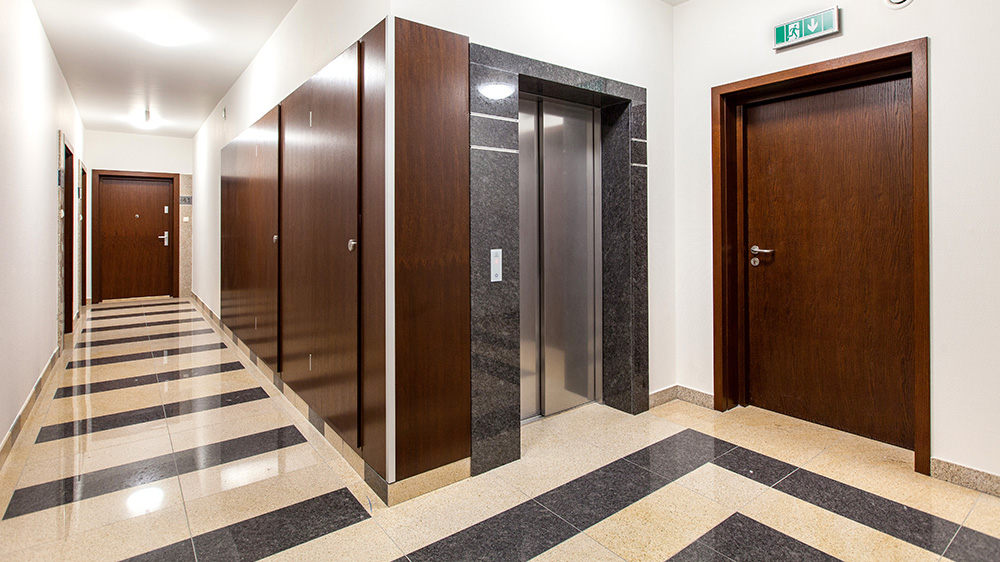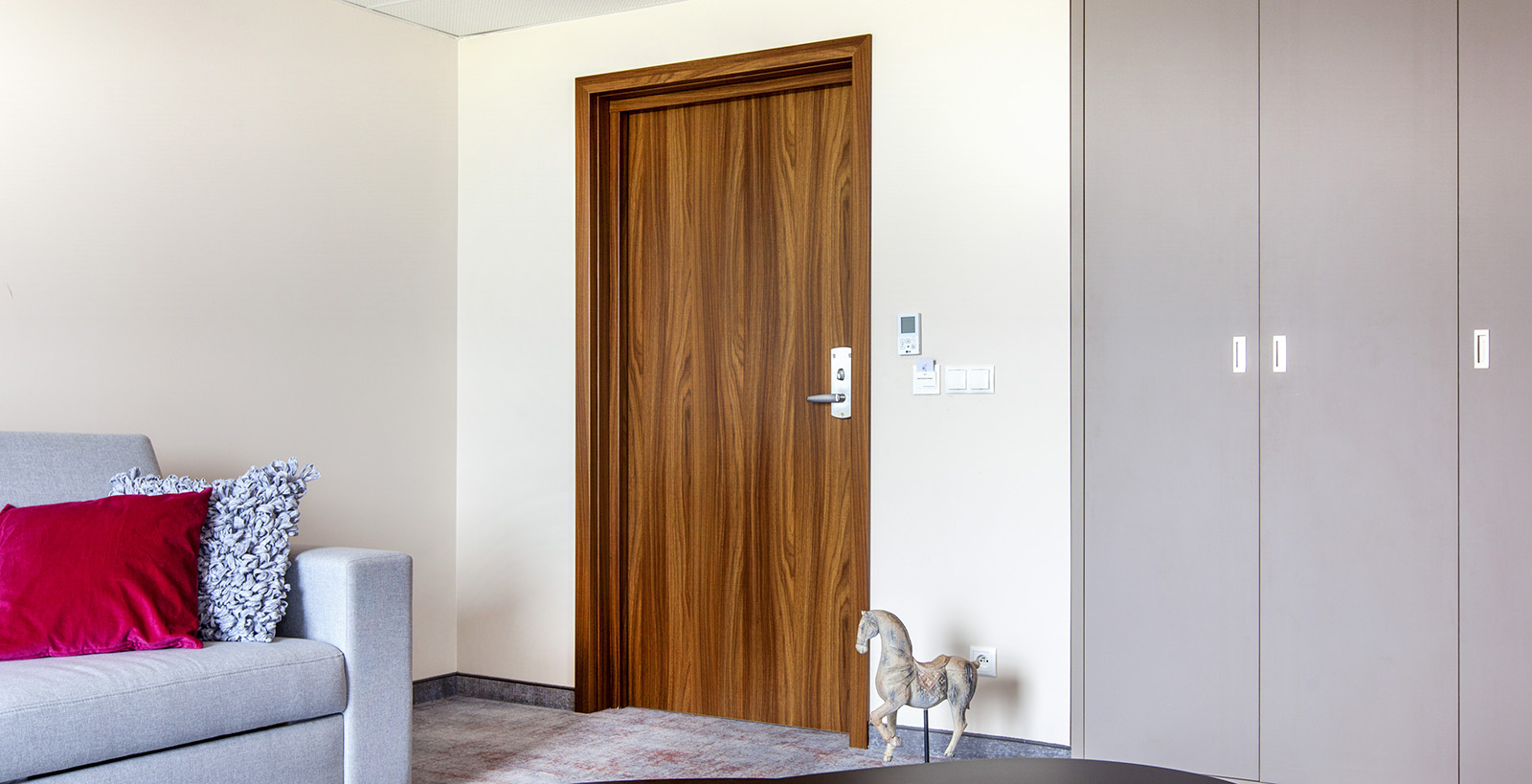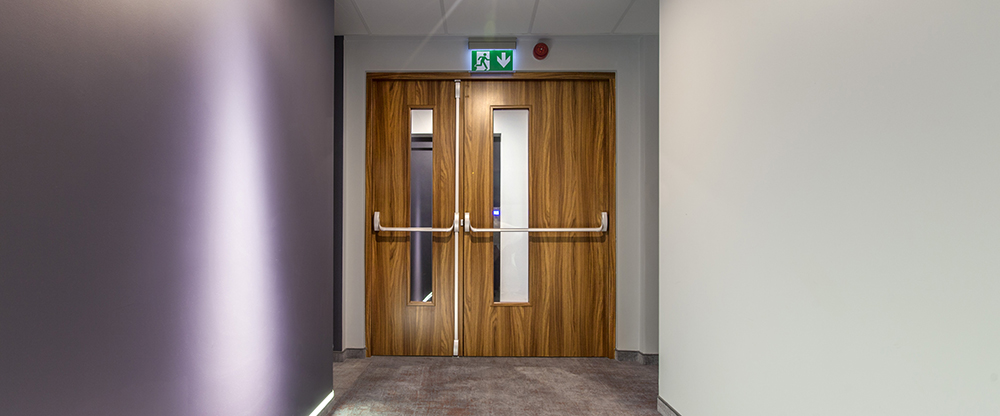Fire doors
Fire doors: The key to building security
In today's world, where the issue of building safety is becoming increasingly important, fire doors are becoming an indispensable part of protecting life and property. These specialised doors are designed to effectively block the spread of fire and smoke, giving valuable evacuation time and reducing property damage. In an emergency situation, a properly selected and installed fire door can literally save lives.
However, it is not just a physical barrier. Fire doors are a key element of any building's fire protection system. Their design and the materials used must meet strict standards to ensure maximum protection. Depending on the needs, different fire resistance classes are available, which determine how long a door can withstand the effects of fire. This directly affects the safety of the building's occupants.
Choosing the right fire door depends on a number of factors, such as:
- Location of the building - different buildings require different levels of protection.
- The purpose of the building - offices, hotels, hospitals or residential buildings have different safety needs.
- Individual security requirements - specific user needs and legislation.
Whether we are talking about offices, hotels, hospitals or residential buildings, fire doors are an indispensable element to ensure safety and peace of mind for all users.

What are fire doors?
Fire doors, also known as fire doors, are specialist structural elements whose main purpose is to stop fire and smoke from spreading through a building. You will encounter them in homes as well as in public or industrial buildings. They play a key role in fire protection systems, enabling safe evacuation and protecting property from fire damage.
To perform their function effectively, fire doors must meet stringent safety standards, such as:
- fire resistance (30 min or 60 min)
- smoke-tightness
- mechanical strength.
As a result, they are able to withstand extreme temperatures for a certain period of time, which is crucial in emergency situations. What's more, they are available in a variety of designs and finishes, allowing them to easily match the aesthetics of any building.
Fire doors can be made from a variety of materials such as:
- steel,
- wood,
- aluminium,
Each of these materials has its own unique properties that affect both the functionality and appearance of the door. The choice of the right material depends on the specific needs of the facility, allowing the door to be perfectly matched to the technical and aesthetic requirements.

Fire doors
The fire resistance ratings of fire doors are a key factor in determining their effectiveness against fire and smoke. Designations such as EI 30, EI 60 or EI120 are not a coincidence. The ‘E’ stands for fire tightness, i.e. the ability of the door to stop flames and hot gases from reaching the other side. The ‘I’, on the other hand, is fire insulation, which indicates how well the door limits the temperature rise on the side not exposed to the fire.
Each fire resistance class, for example EI 30 or EI 60, determines how long a door can effectively protect against fire and smoke. For example:
- EI30 - protection for 30 minutes,
- EI60 - protection for 60 minutes,
The choice of the appropriate class depends on the specifics of the building and its purpose, which is of paramount importance for the safety of users.
EI30 fire doors - protection for 30 minutes
EI 30 fire doors are a popular choice in residential buildings and public facilities such as offices, schools and hospitals. They provide 30 minutes of protection against fire and smoke, which is sufficient in many standard fire situations. Thanks to their design, they effectively prevent the spread of flames, giving time for evacuation and emergency services to intervene.
The decision to choose an EI 30 fire door is often based on legal requirements and the specifics of the building in question. In locations with a moderate risk of fire, such doors provide an adequate level of safety without the need to invest in more advanced solutions.
EI60 fire doors - protection for 60 minutes
EI60 fire doors offer 60 minutes of protection, making them ideal for buildings with a higher risk of fire, such as warehouses, hotels or hospitals. In areas where the fire risk is higher, the extra protection time can be crucial to the safety of people and property.
The use of EI60 doors is often required by building regulations in facilities where fire is more likely to occur. Due to their strength and effectiveness, these doors are an important part of the fire protection system, providing additional time for evacuation and rescue operations.
Wooden fire doors - aesthetics and functionality
Wooden fire doors combine elegance with functionality, making them a popular choice in residential buildings. Thanks to their lighter construction and natural appearance, they blend in perfectly with interiors, adding warmth and class. What's more, they can be fitted with a fire-resistant core, giving them adequate protection against fire.
- Elegant, natural look
- Lighter construction
- Adequate fire protection thanks to fire-resistant core
- Ideal for homes, flats and other places where aesthetics matter
The aesthetics of wooden doors make them a frequent choice for homes, flats and other places where appearance is important. However, their functionality is not inferior to other types of doors, making them a versatile solution for many applications.
Single leaf doors - ideal for smaller spaces
Single leaf fire doors are the perfect solution for smaller spaces such as:
- boiler rooms,
- garages.
Their compact design makes them easy to install and they do not take up much space, which is particularly important in confined spaces. Despite their small size, these doors effectively block the spread of fire and smoke, creating a robust protective barrier.
Single leaf internal fire doors are popular not only for their functionality, but also for their aesthetics. They can be easily matched to a variety of interior styles, allowing them to integrate harmoniously into their surroundings. As a result, in addition to enhancing security, they also help to make optimal use of the available space.
Double-leaf doors - the solution for larger spaces
Double leaf fire doors are the ideal solution for larger spaces such as:
- warehouses,
- offices,
- hotels.
Thanks to their two wings, they allow the free movement of people and goods, which is particularly important in high-traffic areas. In addition to fire protection, these doors offer a high level of functionality, making them indispensable in large establishments.

Safety-enhancing accessories
Fire door accessories play a key role in enhancing the effectiveness and functionality of fire doors. They not only keep these doors safe from fire and smoke, but also offer additional benefits such as facilitating evacuation or improving aesthetics. Here are some accessories that can significantly increase the level of safety in buildings.
Intumescent seals - protection against smoke and fire
Intumescent seals are one of the most important components of fire doors, which increase their ability to stop fire and smoke. These special seals, installed in doors, react to high temperatures by expanding and forming a barrier that blocks oxygen and smoke from entering the room. In this way, they effectively prevent the spread of flames and harmful gases, which is key to protecting building occupants.
Panic hardware - rapid evacuation in emergency situations
In an emergency situation such as a fire, every second counts. Panic fittings are mechanisms fitted to fire doors that enable them to be opened quickly and intuitively. Even in stressful moments, people can easily leave the affected area, significantly increasing evacuation safety. Thanks to their simplicity of operation, these fittings are indispensable in situations where time is of the essence.
Fire-rated glazing - safety without loss of visibility
Fire-resistant glazing is an element that can be integrated into fire doors without losing their fire-stopping effectiveness. Thanks to the use of special materials, these glazings can withstand high temperatures, allowing visibility to be maintained without compromising safety. This is particularly important in areas where visual control is essential, such as escape corridors and high-traffic rooms.
Where to install fire doors?
Choosing where to install fire doors is crucial to the safety of the entire building. These specialised doors are an essential element of fire protection and their correct location can significantly increase the effectiveness of the security system. The decision on where to locate them depends on the specifics of the building and the potential fire hazards that may be present. It is therefore worth thinking carefully about where to install them.
Boiler rooms - protection in areas of high fire risk
Boiler rooms are some of the most important places where fire doors are essential. Due to the presence of heating equipment and flammable materials such as fuels, these rooms have an increased risk of fire. Fire doors in boiler rooms play a key role in:
- limiting the spread of fire,
- protecting the building and its occupants,
- isolating flames from other parts of the building.
They can effectively isolate flames from other parts of the building, which can literally save lives in an emergency situation.
Garages - preventing the spread of fire
Garages are further places where the installation of fire doors is absolutely necessary. Flammable materials such as fuels or oils are often stored there, which increases the risk of fire. Fire doors in garages are designed to:
- prevent fire from entering other parts of the building,
- protect property and life,
- provide an additional level of security.
Their presence can prove decisive in the event of a fire.
Stairwells - a key element of escape routes
Stairwells play an extremely important role during evacuation in the event of a fire. Stairwell fire doors are an indispensable part of the escape route for safe evacuation from a building. They make it possible to:
- keep the escape route free from smoke and fire,
- ensure a quick and safe evacuation.
In an emergency situation, these doors can make the difference between a safe exit and a life-threatening one.
Hospitals - protecting patients and staff
In hospitals, fire doors are an indispensable part of the security system, protecting both patients and staff. Due to the nature of medical facilities, where there are people with limited mobility, these doors must provide:
- maximum protection against fire,
- safe evacuation,
- protection against the spread of fire.
This is essential for maintaining safety in emergency situations.
Offices and hotels - safety in places of work and leisure
Offices and hotels are places where fire doors play an important role in ensuring safety. In offices, these doors protect against fire by safeguarding:
- employees
- valuable documents
- equipment.
In hotels, on the other hand, fire doors are crucial for the protection of guests, ensuring their safety in the event of a fire. Their presence in these establishments not only meets legal requirements, but also creates trust and a sense of security among users.
Technical specifications for fire doors
The technical parameters of fire doors are crucial to their effectiveness in protecting against fire and smoke. When choosing a door, it is worth paying attention to several important aspects:
- Fire resistance: Determines how long the door can withstand the effects of fire. This parameter is indicated by the symbols EI30, EI60, which indicate the protection time in minutes.
- Smoke tightness: Prevents smoke from entering other rooms, which is crucial for safe evacuation.
- Sound insulation: In some cases, especially in public buildings, it is important that the door also provides noise protection.
- Dimensions and design: Doors can be single or double-leafed, which affects their use in different spaces.
Choosing a fire door with the right technical parameters is key to ensuring the safety and functionality of a building. For this reason, it is advisable to carefully analyse your needs before making a purchasing decision.
Installation of fire doors
The installation of a fire door is a key moment that directly affects its effectiveness in protecting against fire and smoke. Even the best doors can lose their properties if they are not installed correctly. It is therefore essential that the entire process is carried out in accordance with the applicable standards and the manufacturer's recommendations.
During installation, it is worth paying attention to several key aspects:
- Fitting the door to the door opening -ensures airtightness and smoke protection.
- Use of appropriate installation materials - must be heat resistant.
- Correct installation - fire doors must allow safe evacuation in emergency situations.
How do you properly install a fire door?
Wondering how to install a fire door correctly? Here are some key steps to consider:
- Preparation of the door opening - make sure it meets all technical requirements.
- Door placement - the door must be perfectly level and centred, ensuring it closes and opens correctly.
- Robust fixing - use suitable anchors and screws that are resistant to high temperatures.
- Intumescent seals - in the event of a fire, increase the tightness of the door.
- Functional tests - make sure the door works properly and meets all safety standards.
The most common mistakes when installing fire doors
Several mistakes can be made when installing fire doors that can significantly reduce their effectiveness. Here are the most common of these:
- Improper fitting of the door to the opening - leads to leaks and loss of smoke protection.
- Use of unsuitable installation materials - materials that are not resistant to high temperatures can damage the door in the event of a fire.
- Lack of intumescent seals - reduces the effectiveness of the door in emergency situations.
- Improper door levelling - can lead to problems with closing and opening, which is particularly dangerous during an evacuation.
To avoid these mistakes, it is advisable to use professionals who are experienced in the installation of fire doors.





